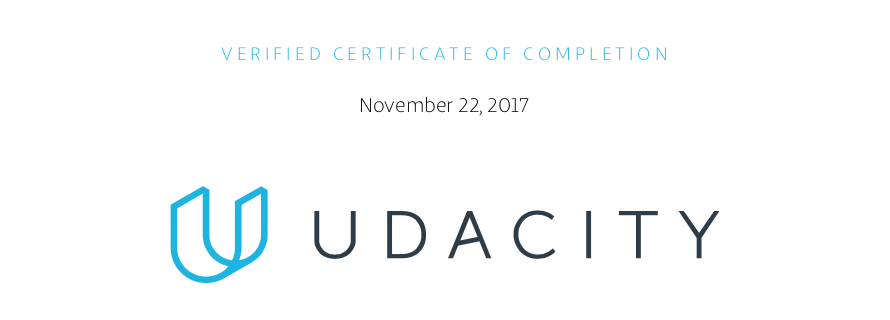The Data Analyst Nanodegree

Since I finished the last of my mandatory DAND project at Udacity in November last year a lot has happened, but I thought it might be valuable to go back and have a look at what I did during these months and how the nanodegree has changed since i started my journey early 2017.
In my initial post written in the beginning of march I listed the projects included as seen here below.
- P0, Analyze Bay Area Bike Share Data (Optional intro to the data analysis workflow and Jupyter notebook)
- P1, Test a Perceptual Phenomenon (Statistical tests and drawing conclusions based on data)
- P2, Investigate a Dataset (Using numpy and pandas to answer questions with and about datasets)
- P3, Wrangle OpenStreetMap Data (Munge and clean up OpenStreetMap data for a part of the world you care about)
- P4, Explore and Summarize Data (Apply exploratory data analysis techniques on a selected dataset using R)
- P5, Identify Fraud from Enron Email (Use machine learning to identify possible fraud with emails and financial data)
- P6, Make effective Data Visualization (Create data visualizations according to current best practices with dimple.js or d3.js)
- P7, Design an A/B Test (Design and analyze an A/B test in order to find improvements to a website)
After 8 months of studies and a few changes to the curriculum from Udacity the projects I eventually worked on and finished before graduating from the program where the following.
- P0, Analyze Bay Area Bike Share Data (Optional intro to the data analysis workflow and Jupyter notebook)
- P1, Test a Perceptual Phenomenon (Statistical tests and drawing conclusions based on data)
- P2, Investigate a Dataset (Using numpy and pandas to answer questions with and about datasets)
- P3, Wrangle OpenStreetMap Data (Munge and clean up OpenStreetMap data for a part of the world you care about)
- P4, Explore and Summarize Data (Apply exploratory data analysis techniques on a selected dataset using R)
- P5, Identify Fraud from Enron Email (Use machine learning to identify possible fraud with emails and financial data)
- P6, Data Visualization in Tableau (Understand the importance of data visualization. Know how different data types are encoded in visualizations. Select the most effective chart or graph based on the data being displayed.)
What changed between when I started the program and when I finally finished it was that the data visualization project changed from a D3.js project to a project using tableau and that the A/B testing project became optional instead of mandatory for the program. Personally, I believe the changes where favourable.
It seems like the D3.js course had been difficult for participants in the program without prior experience in javascript, which isn’t a prerequisite for the Data Analysis Nanodegree, and while the A/B testing course seemed really useful for anyone who will end up in a role focused on marketing or web-based services I didn’t felt that the course was as indispensable as the other projects in the program for an aspiring data analyst or data scientist.
To be honest the changes allowed me to catch up with my original schedule and be on time since the EDA and Machine learning projects took longer time to finish than I expected. All in all, after all the changes, I finished just a couple of weeks later than my initial goal in the end of October. However, since I had my heart set on the two projects that went optional during my studies I have a strong feeling I will get back to them somewhere during 2018.
I think it is also necessary to mention that just as I finished of the last project there was an even bigger change of the DAND program and the above described projects and the self-paced structure of the program has been swapped for one where there are two 3 months terms and fixed fees for each step. I do see some of the benefits using this model, such as a stronger group affiliation for the participants in each semester, but I honestly don’t know I would have been able to go through the program after the current changes since committing to only a three month period for each step would have been hard due to my work schedule. For the latest information about the nanodegree program please refer to the Udacity homepage since they are always actively working on and changing the program contents.
As a last note, for anyone thinking about joining the Data Analyst Nanodegree or any other online course I can’t recommend it highly enough. As a complement to an already existing degree and work experience this is a great way to enable a career change or promotion depending on your own goals and/or current position. For me who joined while Udacity ran their cashback campaign the value was great. For $100 a month I was able to change my career track from IT infrastructure delivery to data science which on paper doesn’t sound a lot but it would have taken much more effort without the framework provided by the program and the healthy dose of pressure given by the monthly fee payment.
If you are Questioning if any online credentials are worth it or not I would like to answer that they all amount to the value you yourself create around it. Since online universities doesn’t have a long history to their name or high criteria of admittance to rely on as a insurance for their alumni quality you have to make an effort to show your work yourself and create a story around why you choose to go through with the program. The fee and time investment necessary is not insignificant but I would dare to say that given the different option available today there are no excuse for anyone not content with their current occupational situation to take the matter in their own hands.